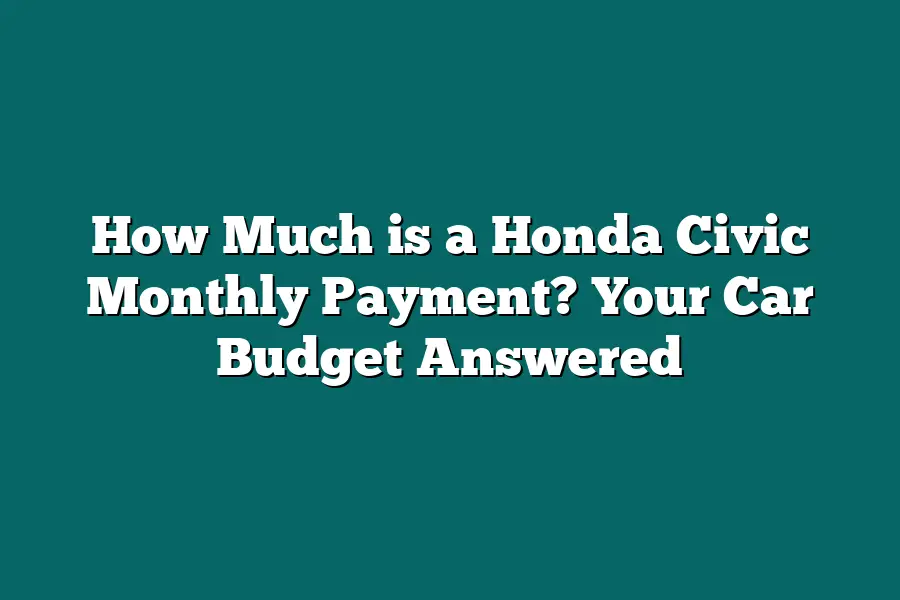The cost of a Honda Civic monthly payment varies depending on several factors such as the trim level, mileage, and financing options. On average, a brand new Honda Civic with a starting price around $20,000 can have a monthly payment ranging from $250 to $450, assuming a 5-year loan at an interest rate of around 4-6%. However, leasing a Honda Civic can result in lower monthly payments, typically between $150 to $300 per month.
As someone who’s passionate about cars and smart financial planning, I know how frustrating it can be to wonder whether a Honda Civic is within your reach.
With its reputation for reliability, fuel efficiency, and affordability, the Civic is a top choice for many drivers.
But let’s face it – understanding the true cost of owning one can be overwhelming.
That’s why I’m excited to dive into the world of Honda Civic prices and payments, breaking down the factors that affect your monthly payment and providing you with a clear-eyed look at the costs involved.
Whether you’re a first-time buyer or a seasoned car owner looking to upgrade, it’s essential to have a solid grasp on what you can afford.
In this post, we’ll explore the Honda Civic’s trim levels and price ranges, as well as the key factors that influence your monthly payment – from credit score to down payment, interest rate, and loan term.
We’ll even crunch some numbers to give you a better idea of what your monthly payment might look like.
So, let’s get started and take the mystery out of calculating your car budget!
Table of Contents
Understanding Honda Civic Prices and Payments
Hey there!
Are you in the market for a new ride?
If so, you’re probably wondering how much that shiny new Honda Civic will set you back each month.
Well, wonder no more!
In this post, we’ll dive into the world of Honda Civic prices and payments, and give you the lowdown on what to expect.
The Lowdown on Honda Civic Trim Levels and Prices
The Honda Civic is a popular choice for many car shoppers, and it’s easy to see why.
With its reputation for reliability, fuel efficiency, and affordability, it’s no wonder that this ride is a top pick for many drivers.
But one of the most common questions I get asked is: “How much does a Honda Civic cost?” Well, let me tell you – it depends on which trim level you’re looking at.
The 2022 Honda Civic comes in several trim levels, each with its own unique features and price tag.
Here’s a quick rundown:
- LX: The base model, starting at around $20,000
- Sport: A step up from the LX, with some sporty styling touches and a price tag of around $23,000
- EX: A mid-range trim with more standard features and a sticker price of around $25,000
- EX-L: The top-of-the-line model, loaded with luxury features like leather seats and a moonroof, priced at around $30,000
Factors That Affect Your Monthly Payment
So, you’ve picked out your perfect Honda Civic.
Now it’s time to think about the monthly payment.
But how much will that be?
Well, there are several factors that come into play:
- Credit Score: Your credit score plays a huge role in determining what interest rate you’ll qualify for. And let me tell you – it can make a big difference! According to myFico, a good credit score (700-749) can save you around $1,000 per year on your car loan compared to a poor credit score (600 or below).
- Down Payment: The more you put down upfront, the less you’ll have to borrow. And that means lower monthly payments!
- Interest Rate: As I mentioned earlier, your credit score can affect your interest rate. But what’s considered “good” and what’s considered “bad”? According to Bankrate, the average 60-month car loan interest rate for a good credit score is around 5%. For a poor credit score? That jumps up to around 10%.
- Loan Term: How long you take to pay off your loan can also impact your monthly payment. The longer you take, the more interest you’ll accrue – and that means higher payments!
Example Time: A 2022 Honda Civic LX
Let’s put these factors into practice with an example.
Say you’re looking at a 2022 Honda Civic LX with a sticker price of $20,000.
You’ve got a good credit score (700-749), so you qualify for that average 5% interest rate.
You decide to put down 10% upfront ($2,000) and take out a 60-month loan.
Using my trusty calculator (and some fancy math), I came up with the following:
- Monthly payment: around $350
- Total interest paid over the life of the loan: around $4,500
Of course, this is just one example – your actual monthly payment will depend on your individual circumstances.
But hopefully, this gives you a better idea of what to expect.
And there you have it – a breakdown of Honda Civic prices and payments!
Whether you’re a car shopping newbie or a seasoned pro, I hope this post has given you the information you need to make an informed decision.
Happy shopping!
Breaking Down the Costs: Insurance, Gas, Maintenance, and More
So, you’ve got your eye on a Honda Civic, but you’re wondering what it’ll really set you back each month.
I’m here to give you the lowdown – and some tips to help you reduce those costs.
Insurance: The Silent Killer of Your Car Budget
When calculating your monthly payment, we often focus on the sticker price of the car.
But insurance?
That’s where things get tricky.
According to the Insurance Information Institute (III), the average annual premium for a Honda Civic is around $1,200 – that’s $100 per month!
Ouch.
Now, I know what you’re thinking: “Can’t I just shop around for cheaper insurance?” Absolutely!
Compare quotes from multiple providers, and don’t be afraid to negotiate.
You might be surprised at the difference it can make.
Gas: The Gas Guzzler’s Worst Nightmare
Next up: gas.
Depending on your driving habits, you might be looking at a daily commute, road trips, or just casual cruising around town.
According to the US Energy Information Administration (EIA), the average fuel economy for a Honda Civic is around 32 miles per gallon.
Not too shabby!
But here’s the thing: with gas prices fluctuating like a teenager’s mood swings, it’s hard to predict what your monthly gas costs will be.
On average, you might spend around $100-150 per month on gas, depending on your mileage and fuel efficiency.
Maintenance: The Forgotten Car Expense
Last but not least: maintenance.
We often forget that our cars need TLC (tender loving care…
and a tune-up every now and then).
According to AAA’s 2020 Vehicle Maintenance Survey, the average American spends around $1,000 per year on car repairs.
For a Honda Civic, you might expect to spend around $50-100 per month on maintenance.
That adds up quickly!
But hey, it’s better to be safe than sorry – keep those records and stay on top of your car’s needs.
The Bottom Line: Your Car Budget in Action
So, let’s recap.
Adding insurance, gas, and maintenance to our initial monthly payment example might increase the total cost to around $500-600 per month.
That’s not chump change!
But here’s the thing: it’s all about prioritizing your spending.
If you can find ways to reduce those costs – like shopping around for insurance or maintaining your vehicle regularly – you’ll be saving big time.
Stay tuned for more car-buying wisdom, and don’t forget to check out our next post for !
Calculating Your Car Budget: A Step-by-Step Guide
Are you ready to take the keys to a shiny new Honda Civic?
Before you start shopping, it’s crucial to figure out how much that monthly payment is going to be.
After all, you don’t want to end up with a car payment that’s eating away at your bank account.
To help you get started, I’m breaking down the steps to calculate your car budget into a simple, straightforward guide.
Follow along, and we’ll get you driving off into the sunset in no time!
Step 1: Determine Your Income and Expenses
Before you start calculating your car budget, it’s essential to get a clear picture of where your money is going.
Take out your latest paycheck stub or bank statement and make a list of your monthly income.
Now, let’s get real for a second – we all have expenses beyond just the basics like rent/mortgage, utilities, and groceries.
You might be paying off student loans, credit card debt, or even mortgage insurance.
Don’t worry, I won’t judge you!
Grab a piece of paper or open up your favorite spreadsheet tool (I’m a Google Sheets fan myself).
Write down all your monthly expenses, including that pesky Netflix subscription.
Step 2: Calculate Your Debt-to-Income Ratio
Now that we have your income and expenses in check, it’s time to calculate your debt-to-income ratio.
This will give us a better idea of how much of your income is going towards debt repayment each month.
The formula is simple:
Debt-to-Income (DTI) Ratio = Total Monthly Debt Payments / Gross Income
For example, let’s say you have a gross income of $4,000 per month and total monthly debt payments of $1,500.
Your DTI ratio would be 0.375 or 37.5%.
What’s the ideal DTI ratio?
Aim for 36% or lower to keep your debt under control.
Step 3: Set a Realistic Target for Your Monthly Payment
Now that we have your income and expenses in check, it’s time to set a realistic target for your monthly car payment.
Consider how much you can afford to spend each month without breaking the bank.
As a general rule of thumb, the 20/4/10 rule is a great starting point:
- Put down 20% of the car’s purchase price as a down payment
- Finance the car for 4 years or less
- Keep your monthly payment under 10% of your take-home pay
For a Honda Civic with a sticker price of $23,000 and a 20% down payment, your target monthly payment might be around $450.
Step 4: Consider Trade-Offs Between Expenses
Finally, let’s talk about trade-offs.
You might have other financial goals or expenses that you need to consider when calculating your car budget.
Ask yourself:
- Can I afford a higher monthly payment if it means I can pay off my student loans faster?
- Should I prioritize paying off high-interest debt before taking on a new car loan?
Consider your priorities and make adjustments accordingly.
And there you have it – the step-by-step guide to calculating your car budget!
By following these simple steps, you’ll be well on your way to determining how much that Honda Civic monthly payment is going to be.
Happy shopping!
Final Thoughts
As I wrap up this journey into the world of Honda Civic prices and payments, I’m left with a crucial takeaway: understanding your car budget is just as important as knowing the sticker price.
By considering all the costs involved – from insurance to gas to maintenance – you can make an informed decision that aligns with your financial goals.
For me, this exercise has been a refreshing reminder of the importance of prioritizing my finances.
As someone who’s always looking for ways to optimize their expenses, I appreciate the simplicity and effectiveness of the steps outlined in this guide.
By following these steps, you too can take control of your car budget and make smart choices that set you up for long-term financial success.
So, there you have it – a comprehensive look at how much a Honda Civic monthly payment might be, along with practical tips to help you calculate your own car budget.
Whether you’re in the market for a new ride or just looking to get a handle on your finances, I hope this post has been a valuable resource.

